Production under John Lund
When Carl Fritjof Lund died in 1921, his son John Lund took over the company. At that time, Aledal was Sweden’s only factory specializing in key manufacture. If we compare the keys in Carl Fritjof’s paper-bound catalogue from 1896 with John’s catalogue from 1933, we find only small alterations to the product range. This is also true of the catalogue covers, which only effectively differ in name. The 1933 catalogue, however, has a new layout with actual-size photographs of the keys, offset-printed on loose-leaf glossy paper. Most of the same keys are still in the range, with only a few design modifications. The same applies to the catalogues for 1944 and 1961: John Lund effectively sticks to the same products.
John also made sure to secure his electricity supply by building a power plant in 1934 to replace a turbine that ran a small JMW generator (JMW – Jönköpings Mekaniska Werkstad), which had been housed in the old factory building for ten years. In doing this, he dismantled the waterwheel whose cogs, suspended transmissions and belt-drives had been powering the machines for 60 years. In the new power plant, he installed two turbines, which powered generators of 25 kW and 40 kW.
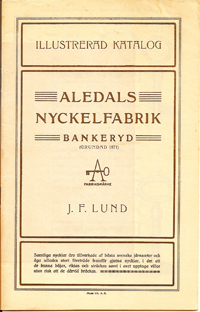 |
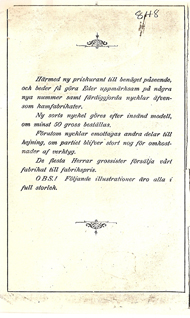 |
|
The 1926 product catalogue with John’s initials.
|
Introduction to the catalogue. |
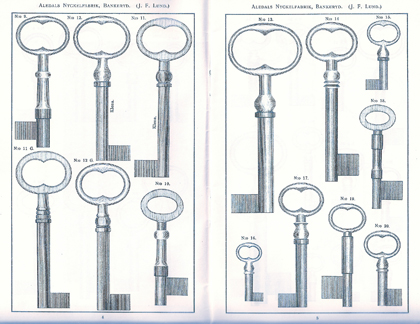 |
| Key blanks for chamber locks, cabinet and rim locks, locks for storage buildings and tool sheds, etc. From the 1926 catalogue. |
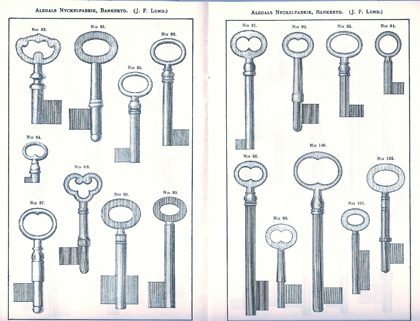 |
| Key blanks for spring-latch locks and outer and inner door locks. From the 1926 product catalogue. |
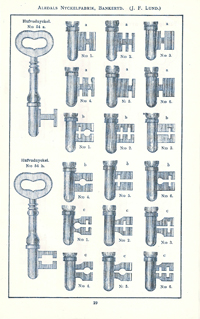 |
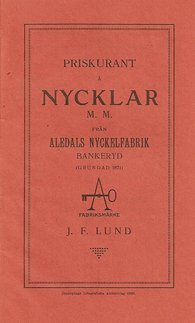 |
|
Two lock systems with master keys. From the 1926 product catalogue.
|
Special offers, 1926. |
During the Second World War, like so many other industries around the country, Aledal received numerous orders from the government. The 1961 catalogue includes forged eccentric clasps and bridle bits of various sizes alongside its wide range of keys.
This includes blanks for padlocks and box locks, cabinet and rim locks, chamber locks, outer door locks, spring-latch locks, cloakroom locks, safes and cash-boxes, store rooms and tool sheds. There are also a large number of finished keys (with filed bit). The company’s machinery and tools were many and varied but relatively old. Along with the seven very prominent Munktell drop hammers were four forges, ten eccentric presses, four drills, three grinding and cutting machines, two sawing and planing machines and a turning lathe.
Sales
Aledal was both a contractor and a subcontractor. As the latter the company had well-established customers including Rosengrens Kassaskåpsfabrik in Göteborg (1920), August Stenman (1941), Assa Stenman AB (1980–83), Nordgas (1940), Ruko (1945, 1946), AB Möbellås in Eskilstuna (1942, 1943, 1951, 1960, 1975), LM Ericsson (1937, 1962) and Postverket (1928, 1931), all of which bought keys.
As a subcontractor to Husqvarna and Bolinders, Aledal also sold meat grinder blades.
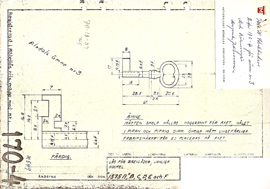 |
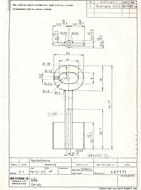 |
| Design for a key blank for AB Möbellås, Eskilstuna |
Design for a key blank for GKN-Stenman AB |
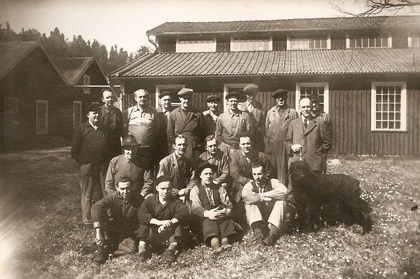 |
| John Lund with workers and dog outside the office (old factory). |
The employees
The number of employees peak at about 20 in the 1960s. Most of them lived in or near Aledal, and when the old Norget building could no longer accommodate them all, new Norget was built with one two-room apartment, three one-room apartments and three simple bachelor flats. The foreman was given Solhem, another newly built residence containing two rooms and a kitchen.
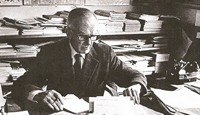 |
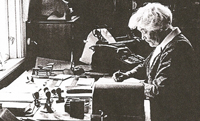 |
| Dagmar Stolley and John Lund at the office. From the Bankeryd Photography Club. |
Fifty years later, in the company’s centenary year of 1971, John was running the business with five or six employees and manufacturing some two million keys a year, making Aledal the largest producer of keys in Sweden. Previously, the maximum number of keys produced annually touched six million.
John died in 1975, and the following year the factory burned down.